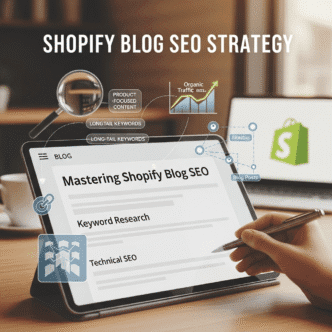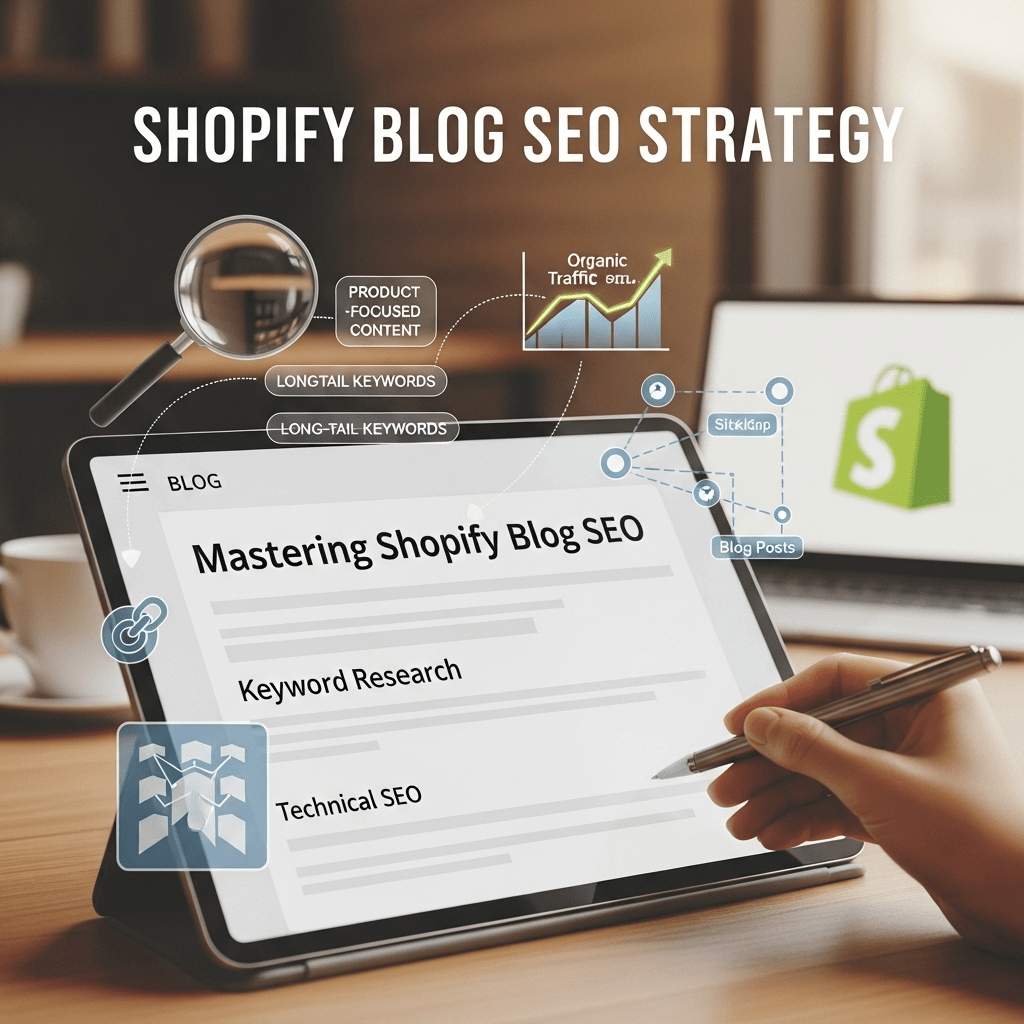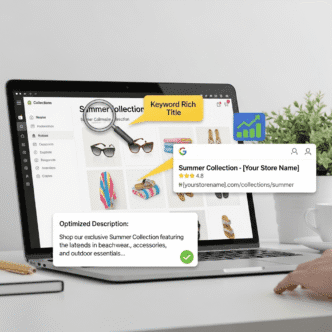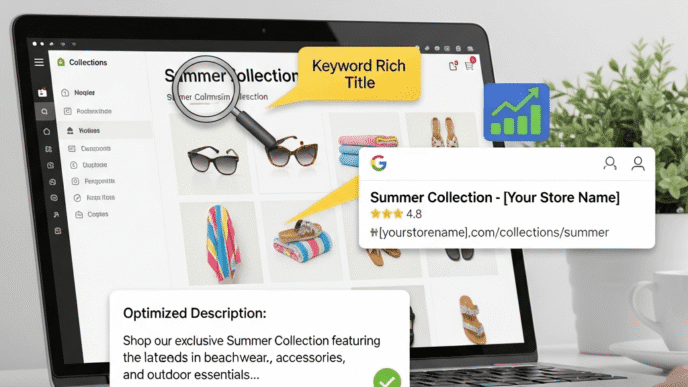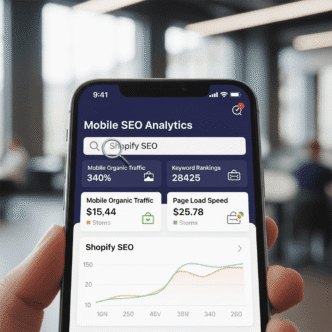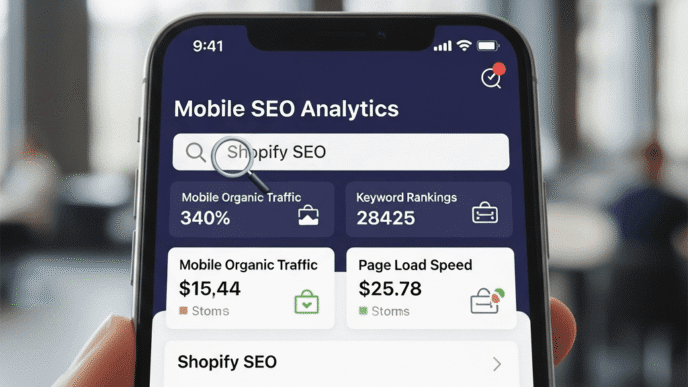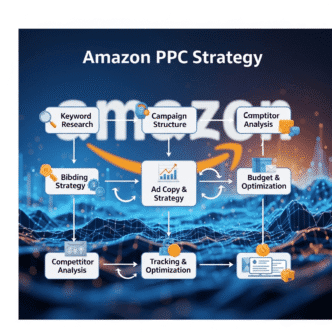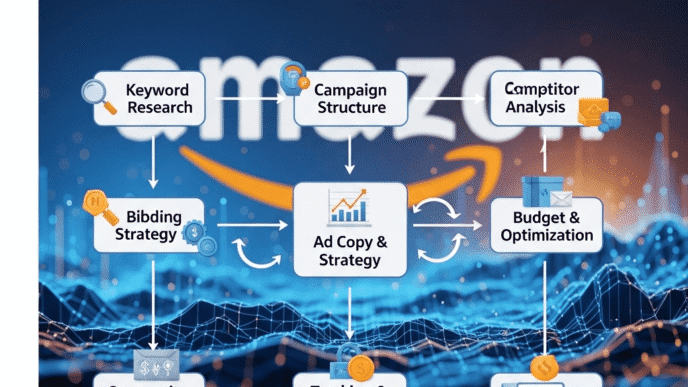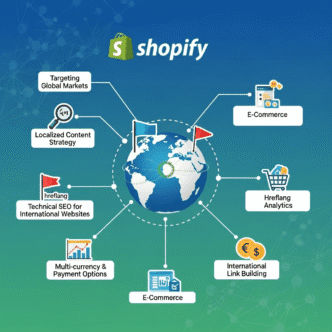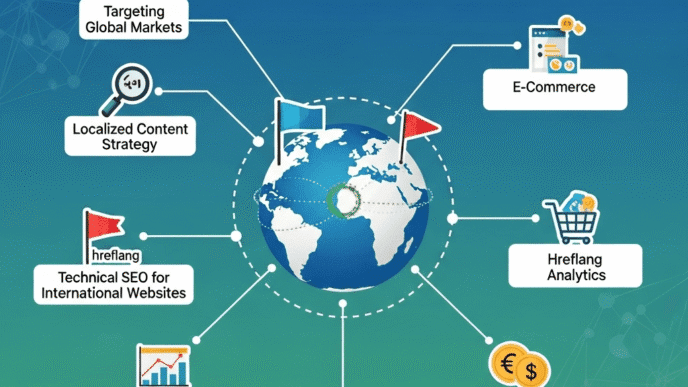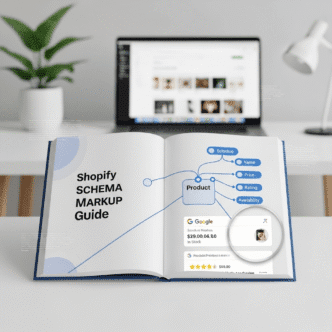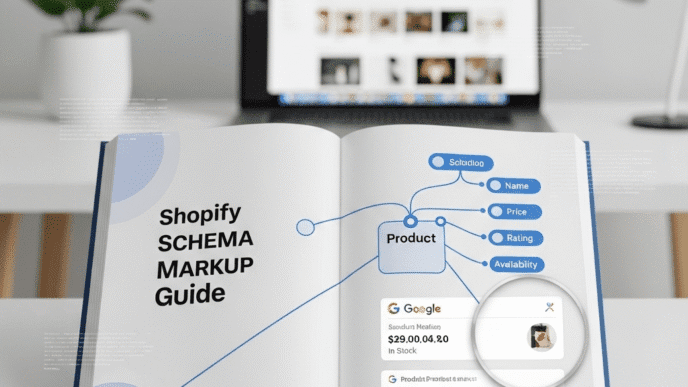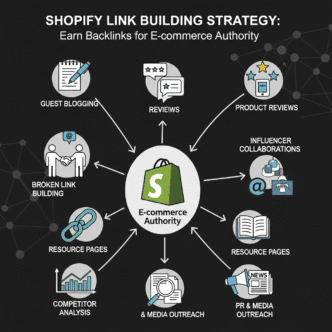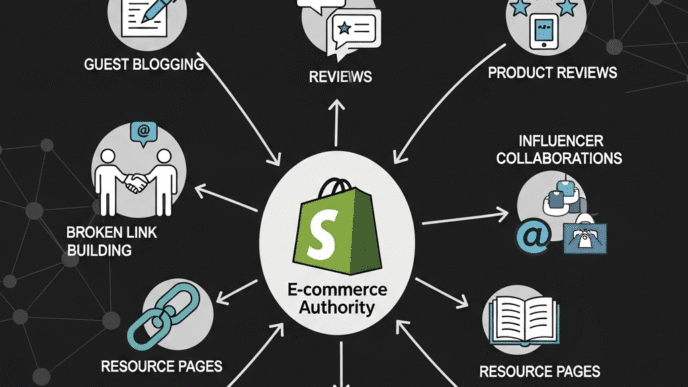Your Shopify store has amazing products. Your prices are competitive. But here’s the gut-punch: you’re invisible on Google, and the only traffic you’re getting is from expensive ads that drain your bank account faster than a leaky faucet.
Sound painfully familiar?
Here’s what most Shopify store owners miss: your blog isn’t just a “nice to have” feature gathering digital dust. When done right, Shopify blog SEO is your secret weapon for ranking on page one, stealing traffic from competitors, and turning browsers into buyers—all without spending a dime on ads.
But here’s the problem: 90% of Shopify blogs are doing it wrong. They’re publishing random content, ignoring keyword research, and wondering why nobody reads their posts. Meanwhile, smart stores are using strategic content marketing to dominate search results and print money.
In this comprehensive guide, I’ll show you exactly how to use Shopify blog to increase organic traffic and sales—from keyword research to content creation to conversion optimization. No theory, no fluff. Just battle-tested strategies that actually work in 2025.
Let’s turn your neglected blog into a traffic-generating, conversion-crushing machine.
Table of Contents
ToggleWhy Is Shopify Blog SEO Critical for E-commerce Success?
Let me hit you with some cold, hard facts: According to HubSpot, businesses that blog get 55% more website visitors than those that don’t. And those visitors? They’re 13x more likely to see positive ROI from their marketing efforts.
Shopify blog SEO solves three massive problems simultaneously:
Ranking for Non-Product Keywords: You can’t rank for “best running shoes” with a product page alone. But a blog post titled “Best Running Shoes for Marathon Training in 2025”? That’s SEO gold.
Building Topical Authority: Google favors sites that demonstrate expertise. A robust blog proves you know your niche inside and out.
Creating Natural Link Opportunities: Nobody links to product pages. But comprehensive, helpful blog content? That earns backlinks naturally, boosting your entire site’s authority.
Real example: Beardbrand, a men’s grooming Shopify store, built their entire business on content. Their blog drives 300,000+ monthly visitors, with many posts ranking #1 for competitive keywords. Those visitors convert at 2.3%—higher than their paid traffic.
For foundational Shopify SEO strategies beyond blogging, start with our definitive Shopify SEO guide.
What Makes Shopify Blogs Different from Regular Blogs?
Your Shopify blog has unique advantages and limitations compared to WordPress or standalone blogs.
Advantages of Shopify’s Blogging Platform
Seamless Product Integration: Link directly to products with native Shopify links that maintain cart functionality.
Built-in E-commerce Tracking: See which blog posts drive actual sales, not just vanity metrics like pageviews.
No Plugin Headaches: Unlike WordPress, you’re not managing 20 plugins that might break or conflict.
Fast, Secure Infrastructure: Shopify handles hosting, security, and speed optimizations automatically.
Limitations to Know
Less SEO Flexibility: You can’t install advanced SEO plugins or modify everything you’d want.
Basic Editor: The content editor is functional but limited compared to Gutenberg or page builders.
URL Structure: Blog posts live at /blogs/news/post-title which isn’t ideal but workable.
No Categories: Shopify uses tags instead of categories, which is less ideal for site structure.
The bottom line? Shopify blogs are perfectly capable of ranking—but you need to work within their constraints strategically.
How Do You Conduct Keyword Research for Shopify Blogs?
Keyword research is where most Shopify blogs fail. They write about random topics and pray Google notices. That’s like fishing without bait.
The Strategic Keyword Research Process
Start with Customer Questions: What do your customers ask before buying? These questions are gold mines for blog topics.
Identify Commercial Intent Keywords: Target keywords that indicate buying intent, not just information-seeking. “Best wireless headphones under $100” beats “what is bluetooth.”
Find Long-Tail Opportunities: Instead of competing for “running shoes” (impossible), target “best trail running shoes for wide feet” (achievable).
Analyze Competitor Blogs: See what’s working for competitors. Tools like Ahrefs or SEMrush reveal their top-performing content.
Check Search Volume and Difficulty: Aim for keywords with 500-5,000 monthly searches and keyword difficulty under 40 (for new blogs) or under 60 (for established ones).
Top Keyword Research Tools for Shopify
| Tool | Best For | Price | Key Feature |
|---|---|---|---|
| Ahrefs | Comprehensive research | $99+/mo | Content gap analysis |
| SEMrush | Competitor analysis | $119+/mo | Topic research tool |
| Ubersuggest | Budget-friendly option | Free-$29/mo | Keyword ideas + difficulty |
| Google Keyword Planner | Free baseline data | Free | Direct from Google |
| AnswerThePublic | Question-based keywords | Free-$99/mo | Visual keyword maps |
| Keywords Everywhere | Browser extension | $10 credits | Quick volume checks |
Pro Process: Start with Ubersuggest or Keyword Planner (free), then upgrade to Ahrefs or SEMrush once you’re generating revenue from content.
Pro Tip: According to Backlinko’s analysis of 11.8 million Google search results, long-tail keywords (4+ words) have a 3-5% higher click-through rate than short keywords. Target the specific, not the generic.
What Types of Blog Content Actually Drive Sales?
Not all blog content is created equal. Some posts generate traffic but zero sales. Others attract fewer visitors but convert like crazy.
High-Converting Blog Post Types
“Best [Product Category]” Roundups: Example: “Best Standing Desks for Home Offices in 2025.” These rank well and directly drive product sales.
Comparison Posts: “Product A vs Product B vs Product C” helps buyers make decisions and positions your products as solutions.
How-To Guides: “How to Choose the Right [Product]” educates buyers and naturally leads to your products as solutions.
Problem-Solution Posts: Identify a pain point, explain it thoroughly, then present your products as the solution.
Ultimate Guides: Comprehensive resources (2,000-4,000 words) that become go-to references in your niche.
Case Studies: Real customer success stories using your products build trust and demonstrate value.
Seasonal Content: “Best [Products] for [Holiday/Season]” capitalizes on predictable search spikes.
Content Types That Rarely Convert
- Random industry news (unless you’re a media site)
- Overly academic content without practical application
- Content with zero connection to your products
- Extremely short posts (under 500 words) lacking depth
- Keyword-stuffed nonsense that reads like robot vomit
Real example: An outdoor gear store wrote “10 Essential Items for Winter Hiking” featuring 10 products they sold. The post ranked #3 for “winter hiking gear essentials” and drove 237 direct product purchases in its first 90 days.
For integrating blog content with your overall site structure, see our Shopify SEO fundamentals guide.
How Do You Optimize Blog Posts for Maximum Rankings?
Writing great content is 50% of the battle. Optimizing it for search engines is the other 50%.
On-Page SEO Checklist for Shopify Blogs
Title Tag Optimization: Include your focus keyword near the beginning. Keep it under 60 characters. Make it click-worthy.
Example: “Best Standing Desks 2025: 12 Ergonomic Options Under $500”
Meta Description: Summarize the post in 150-155 characters, include your keyword, and add a call-to-action.
URL Structure: Edit your URL handle to be short and keyword-rich. /blogs/news/standing-desk-guide not /blogs/news/this-is-the-ultimate-comprehensive-guide-to-choosing
H1 Tag: Your title should be the only H1. Make it compelling and keyword-rich.
H2 and H3 Subheadings: Use descriptive, keyword-inclusive subheadings that break up content and signal topic relevance to Google.
First 100 Words: Include your focus keyword naturally in the opening paragraph (like I did in this post).
Image Optimization:
- Compress images (under 150KB)
- Use descriptive file names (
standing-desk-setup.jpgnotIMG_4732.jpg) - Write keyword-rich alt text
- Add captions when relevant
Internal Linking: Link to relevant product pages (3-5 per post) and other blog posts (2-4 per post).
External Linking: Link to authoritative sources when citing stats or referencing research. It builds trust.
Content Length: Aim for 1,500-2,500 words for standard posts, 3,000+ for ultimate guides. Longer content tends to rank higher.
Keyword Density: Use your focus keyword 3-5 times naturally. Sprinkle related keywords and synonyms throughout.
Engagement Elements: Include lists, tables, quotes, examples, and images every 300-400 words to maintain reader interest.
Pro Tip: According to a Semrush study of 700,000 blog posts, content with at least one image gets 94% more views than content without images. Visual content isn’t optional—it’s essential.
How Should You Structure Your Shopify Blog for SEO?
Your blog optimization strategy isn’t just about individual posts—it’s about creating a logical, crawlable structure.
Ideal Shopify Blog Architecture
Use a Clear Tagging System: Since Shopify doesn’t have categories, tags become crucial. Create 5-10 main tags representing your content pillars.
Examples for a fitness store:
- Workout guides
- Nutrition tips
- Equipment reviews
- Training programs
- Recovery techniques
Create Pillar Content: Write comprehensive “pillar posts” (3,000+ words) on your main topics, then create “cluster content” (shorter posts) linking back to pillars.
Optimize Tag Pages: Edit tag page titles and descriptions. These pages can rank for broader keywords.
Maintain Consistent Publishing: Google favors regularly updated blogs. Aim for 2-4 posts monthly minimum.
Update Old Content: Refresh top-performing posts annually with new information, keeping them relevant and maintaining rankings.
Internal Linking Strategy
Link from Blog to Products: Every post should link to 3-5 relevant products naturally within the content.
Link Between Blog Posts: Connect related posts to keep visitors engaged and help Google understand topic relationships.
Link from Product Pages to Blog: Add a “Learn More” section on product pages linking to relevant blog content.
Breadcrumb Navigation: Ensure your theme includes breadcrumbs (Home > Blog > Category > Post) for better UX and SEO.
A jewelry store implemented strategic internal linking between their 47 blog posts and saw average session duration increase by 38% and pages per session increase from 2.1 to 3.4—both positive SEO signals.
What’s the Perfect Blog Post Structure for Conversions?
Your blog posts should do more than rank—they should convert readers into customers.
The Conversion-Optimized Blog Post Template
1. Hook (First 50 Words): Start with a pain point or curiosity gap that grabs attention immediately.
2. Promise (Next 50-100 Words): Tell readers exactly what they’ll learn and why it matters.
3. Credentials (Brief): Establish authority quickly—why should they trust you?
4. Value-Packed Content: Deliver on your promise with comprehensive, actionable information.
5. Product Integration: Naturally mention relevant products as solutions within the content.
6. Visual Elements: Break up text every 300-400 words with images, charts, or quotes.
7. Featured Product Callout: Highlight 1-2 products in formatted callout boxes mid-content.
8. Social Proof: Include customer reviews, testimonials, or case study snippets.
9. Strong CTA: End with a clear call-to-action. “Shop [Product Category]” or “See Our Top-Rated [Products]”
10. Related Posts: Link to 3-5 related blog posts to increase engagement.
Adding CTAs Without Being Pushy
Natural Product Mentions: “We love the [Product Name] for this exact purpose” with a link.
Helpful Resource Links: “If you need [specific solution], check out our [product category]”
Problem-Solution Format: Describe a problem thoroughly, then present your product as the natural solution.
Comparison Tables: Include your products in comparison tables with competitors (be fair, but highlight your strengths).
Real example: A home decor store wrote “How to Style Small Apartments” and naturally integrated 8 product links where relevant (shelving, mirrors, lighting, etc.). The post ranks #5 for “small apartment decorating ideas” and has generated over $12,000 in attributed sales over 18 months.
External resource: HubSpot’s blog post template provides additional structural frameworks for various content types.
How Do You Actually Drive Traffic to New Blog Posts?
Publishing great content is pointless if nobody reads it. You need a distribution strategy.
Multi-Channel Blog Promotion Strategy
Email Marketing: Send new posts to your email list. Subscribers are your warmest audience.
Social Media: Share on Instagram, Facebook, Pinterest (huge for e-commerce), TikTok, and LinkedIn depending on your audience.
Pinterest SEO: Pinterest is a visual search engine. Optimize pins with keyword-rich titles and descriptions.
Repurpose Content: Turn blog posts into Instagram carousels, YouTube videos, or TikTok series.
Influencer Outreach: If you mention experts or brands in posts, let them know. They might share.
Facebook Groups: Share helpful posts in relevant groups (where allowed, don’t spam).
Reddit: Participate in relevant subreddits. Share content when it genuinely helps (Reddit hates self-promotion, so be genuine).
Paid Boost: Consider $20-50 Facebook/Instagram ad boosts for your best posts to kickstart engagement.
Guest Posting: Write for other blogs in your niche with links back to your content.
Answer Questions: Use your blog content to answer Quora, Reddit, and forum questions (include links when helpful).
The First 48 Hours Are Critical
Google watches how content performs initially. Strong early engagement signals quality.
Day 1 Actions:
- Email your list immediately
- Share on all social channels
- Post in relevant groups
- Engage with comments quickly
Week 1 Actions:
- Reshare on social with different angles
- Reach out to anyone mentioned in the post
- Submit to relevant aggregators (if applicable)
- Monitor and respond to all engagement
A skincare store saw their blog post “10 Ingredients to Avoid in Face Creams” explode to 15,000 views in the first week purely through strategic Pinterest promotion. The post now ranks #2 organically and continues driving 5,000+ monthly visitors.
For broader traffic strategies beyond blogs, explore our Shopify SEO guide.
How Do You Measure Blog SEO Success?
Vanity metrics like pageviews are nice, but what actually matters for your business?
Key Metrics to Track
Organic Traffic Growth: Monitor Google Analytics 4 for organic sessions to your blog over time.
Keyword Rankings: Track where your posts rank for target keywords (use Google Search Console, Ahrefs, or SEMrush).
Assisted Conversions: In GA4, see how many sales involved a blog post in the customer journey.
Direct Revenue Attribution: Use Shopify’s built-in analytics to see sales from blog posts.
Engagement Metrics:
- Average time on page (aim for 2+ minutes)
- Bounce rate (under 60% is good)
- Pages per session (higher is better)
Click-Through Rate: In Google Search Console, see your CTR for blog posts in search results.
Backlinks: Monitor how many external sites link to your blog content (use Ahrefs, Moz, or SEMrush).
Social Shares: Track shares across platforms (native analytics or tools like BuzzSumo).
Setting Realistic Goals
| Timeframe | Realistic Goal |
|---|---|
| Month 1-3 | Publish 8-12 posts, minimal traffic |
| Month 4-6 | 500-1,000 organic monthly visitors |
| Month 7-9 | 2,000-5,000 organic monthly visitors |
| Month 10-12 | 5,000-10,000+ organic monthly visitors |
| Year 2+ | Exponential growth as content compounds |
Important: These are averages for new blogs. Established stores or highly competitive niches may see different timelines.
Pro Tip: According to Orbit Media’s annual blogger survey, bloggers who check analytics “a few times per week” are 2x more likely to report “strong results” compared to those who rarely check. Measure what matters, then optimize relentlessly.
What Role Does AI Play in Shopify Blog Content Strategy?
Welcome to 2025, where AI is reshaping content strategy but not replacing human creativity.
Smart Ways to Use AI for Blog Content
Idea Generation: Use ChatGPT, Claude, or Jasper to brainstorm 50 blog topics in minutes.
Outline Creation: Generate detailed outlines based on top-ranking competitor content.
First Drafts: Let AI create rough drafts, then heavily edit to add personality, brand voice, and expertise.
Meta Descriptions: Generate multiple variations, pick the best one.
Title Options: Create 20 headline options for each post, test the most compelling.
Content Expansion: Have AI elaborate on specific sections that need more depth.
Repurposing: Turn blog posts into social media captions, email newsletters, or video scripts.
What AI Can’t (Shouldn’t) Do
Replace Your Unique Perspective: AI content is generic. Your experience, stories, and insights are what make content valuable.
Fact-Check Itself: AI hallucinates statistics and sources. Always verify everything.
Create Original Research: AI regurgitates existing information. Original data sets you apart.
Understand Your Customers: Only you know your customers’ real pain points and language.
Build Authentic Authority: Google’s E-E-A-T (Experience, Expertise, Authoritativeness, Trust) requires genuine expertise.
The Hybrid Approach That Works
- Use AI for idea generation and rough drafts
- Add your unique insights, experiences, and examples
- Inject personality and brand voice
- Include original data or case studies when possible
- Edit ruthlessly for quality and accuracy
- Add visuals and formatting for engagement
A pet supply store uses AI to generate blog outlines, then has their veterinarian consultant flesh out posts with expert advice. The combination of AI efficiency and real expertise creates content that ranks well and builds trust.
External resource: Google’s AI content guidelines clarify that helpful, people-first content matters regardless of how it’s produced—but quality standards remain high.
How Do You Repurpose Blog Content for Maximum Impact?
One blog post shouldn’t live as just one blog post. Strategic content marketing means extracting maximum value from every piece.
Content Repurposing Strategy
Blog Post → Email Newsletter: Send to your list with a compelling summary and link to full post.
Blog Post → Social Media Carousels: Turn key points into Instagram or LinkedIn carousels (10 slides).
Blog Post → YouTube Video: Record yourself discussing the topic. Embed video in the blog post for engagement boost.
Blog Post → Podcast Episode: Discuss the topic in audio format. Embed in post for multimedia content.
Blog Post → Infographic: Visualize data or step-by-step processes. Infographics earn backlinks.
Blog Post → Pinterest Pins: Create 3-5 different pin designs for each post (Pinterest prioritizes fresh pins).
Blog Post → TikTok/Reels Series: Break content into 15-60 second videos covering one tip each.
Blog Post → Lead Magnet: Expand comprehensive posts into downloadable PDFs (email opt-in required).
Blog Post → Product Descriptions: Use sections of blog posts as expanded product descriptions.
Old Post → Updated Post: Refresh content annually, update stats, and re-publish as current year version.
One fitness apparel store turned their “Ultimate Home Workout Guide” blog post into:
- 6 YouTube videos (150,000 total views)
- 15 Instagram Reels (250,000+ impressions)
- 8 Pinterest pins (12,000 clicks back to site)
- 1 email series (22% open rate, 4.3% click rate)
- 1 downloadable PDF (687 new email subscribers)
That’s one piece of content working in 30+ different formats. That’s leverage.
What Are Common Shopify Blog SEO Mistakes to Avoid?
Let’s talk about the facepalm-worthy mistakes killing most Shopify blogs.
Mistake #1: Publishing Thin, Low-Value Content
The Problem: 300-word posts with no real depth or unique insights.
The Fix: Aim for 1,500+ words with actionable information, examples, and genuine value.
Mistake #2: Ignoring Keyword Research
The Problem: Writing about random topics that nobody searches for.
The Fix: Always start with keyword research. Target terms people actually type into Google.
Mistake #3: Zero Internal Linking
The Problem: Blog posts exist in isolation without linking to products or other content.
The Fix: Every post should link to 3-5 products and 2-4 other blog posts.
Mistake #4: Inconsistent Publishing
The Problem: Posting 5 times one month, then nothing for 6 months.
The Fix: Create a content calendar. Consistency beats volume. 2 posts/month consistently beats 10 posts once.
Mistake #5: Not Optimizing for Mobile
The Problem: Images too large, text too small, formatting broken on mobile.
The Fix: Test every post on mobile devices. 70% of traffic is mobile.
Mistake #6: Ignoring Search Intent
The Problem: Writing an in-depth guide when searchers want a quick list, or vice versa.
The Fix: Analyze top 10 ranking posts for your keyword. Match the format and depth.
Mistake #7: Never Updating Old Content
The Problem: Posts from 2020 with outdated information losing rankings.
The Fix: Update your top 20 posts annually with fresh data, examples, and insights.
Mistake #8: No Clear CTA
The Problem: Great content with no direction—readers leave without taking action.
The Fix: Every post needs a clear next step: shop products, read related posts, or join email list.
A coffee equipment store made mistake #3—zero internal linking. After retrofitting internal links into their 34 existing blog posts, they saw a 41% increase in product page visits from blog traffic within 60 days.
How Long Does It Take to See Results from Shopify Blog SEO?
Let’s set realistic expectations. SEO is a marathon, not a sprint.
Typical Timeline for Blog SEO Results
Months 1-3: The Foundation Phase
- Focus on publishing quality content (8-12 posts)
- Little to no organic traffic yet (this is normal)
- Social and email drive initial traffic
- Laying groundwork for future rankings
Months 4-6: Early Traction
- Some posts start ranking on page 2-3
- Organic traffic reaches 500-2,000 monthly visits
- First signs of ROI appear
- Content starts getting indexed and understood
Months 7-9: Momentum Builds
- Multiple posts hit page 1 for long-tail keywords
- Organic traffic hits 2,000-5,000+ monthly visits
- Meaningful sales attribution from content
- Older content gains authority and climbs rankings
Months 10-12: Compound Returns
- Strong rankings for target keywords
- 5,000-10,000+ organic monthly visitors
- Content marketing becomes significant revenue channel
- Topical authority established in your niche
Year 2+: Exponential Growth
- Dominant rankings for competitive terms
- Blog becomes primary traffic source
- New content ranks faster due to site authority
- True compounding returns on effort
Reality Check: Competitive niches take longer. New domains take longer. But consistency always wins.
Pro Tip: According to Ahrefs’ analysis of 2 million pages, only 5.7% of pages rank in the top 10 within a year of publication. But the pages that do rank provide compounding returns for years. SEO is an investment, not an expense.
External resource: Backlinko’s ranking time study analyzed 1 million search results and found the average top 10 ranking page is 2+ years old.
For understanding the full SEO timeline beyond just blogs, check our comprehensive Shopify SEO guide.
Final Thoughts: Your Shopify Blog SEO Action Plan
Alright, let’s wrap this up with a clear, actionable roadmap for dominating Shopify blog SEO.
Month 1: Foundation
- Conduct keyword research (identify 50-100 target keywords)
- Create content calendar for first quarter
- Write and publish 3-4 high-quality posts
- Set up Google Analytics 4 and Search Console properly
- Optimize blog settings and URL structure
Month 2: Momentum
- Publish 3-4 more posts
- Promote existing content on social media
- Start email newsletter featuring blog content
- Retrofit internal links into all posts
- Begin outreach for backlink opportunities
Month 3: Optimization
- Publish 3-4 additional posts
- Analyze which posts are performing best
- Double down on topics showing traction
- Create pillar content (3,000+ word ultimate guide)
- Update older posts with fresh information
Months 4-6: Scale
- Increase publishing to 4-6 posts monthly
- Expand keyword targeting to adjacent topics
- Repurpose top content into other formats
- Track rankings and adjust strategy
- Begin seeing meaningful organic traffic
Months 7-12: Refine
- Continue consistent publishing
- Focus on conversion optimization
- Update and expand top-performing posts
- Build more internal linking pathways
- Celebrate as traffic and sales compound
The Non-Negotiables:
✅ Publish at least 2 high-quality posts monthly (consistency) ✅ Every post targets a researched keyword (strategy) ✅ Every post links to products and other content (internal linking) ✅ Every post is optimized for mobile (user experience) ✅ Track metrics and adjust based on data (measurement)
The Bottom Line:
Shopify blog SEO isn’t about gaming Google or finding shortcuts. It’s about consistently creating genuinely helpful content that answers real questions, naturally integrates your products, and establishes your expertise.
The stores crushing it with content in 2025 aren’t the ones with the biggest budgets—they’re the ones who started 6-12 months ago and stayed consistent.
Your competitors are either ignoring content marketing (great for you) or starting today (even better for you if you start first).
Every day you wait is another day your competitors could be building their content moat. Start today.
For the complete Shopify SEO picture—technical optimization, product pages, link building, and comprehensive strategy—bookmark our definitive Shopify SEO guide.
Now go write that first blog post. Your future traffic (and bank account) will thank you.
Frequently Asked Questions (FAQs)
Q: How often should I publish blog posts on my Shopify store? A: Aim for 2-4 high-quality posts per month minimum. Consistency matters more than volume. Publishing 2 posts monthly for a year (24 total) beats publishing 12 posts one month then nothing for six months.
Q: How long should Shopify blog posts be for SEO? A: Target 1,500-2,500 words for standard posts, 3,000+ words for comprehensive guides. According to Backlinko’s analysis, the average first-page result contains 1,447 words. Longer, comprehensive content tends to rank higher.
Q: Can I use AI to write my Shopify blog posts? A: Yes, but carefully. Use AI for outlines and rough drafts, then add your unique expertise, brand voice, and real examples. Google’s guidelines emphasize helpful, people-first content—AI is fine as long as quality remains high.
Q: Should I hire a writer or write blog posts myself? A: If you’re not confident in your writing, hiring a niche expert writer is worth the investment ($100-500 per post). But you’ll need to provide product knowledge, brand voice guidelines, and review everything. DIY works if you commit to learning and improving.
Q: How do I link to products without being too salesy? A: Use natural, helpful language: “We love the [Product Name] for this exact purpose” or “If you’re looking for [solution], check out our [product category].” Focus on being helpful first, promotional second.
Q: Do I need to blog about topics unrelated to my products? A: Focus 80% of content on topics directly related to your products and customer problems. The other 20% can be broader industry content that builds authority. Everything should connect to your niche somehow.
Q: How many internal links should I include in each blog post? A: Include 3-5 links to relevant product pages and 2-4 links to other blog posts. Don’t force it—link naturally when products or other content genuinely adds value to the reader.
Q: What if my niche is boring and I can’t think of blog topics? A: No niche is boring—only boring angles. Even “boring” products solve problems. Focus on customer questions, pain points, comparison content, and how-to guides. Your customers’ problems are your content goldmine.
Q: Should I allow comments on Shopify blog posts? A: Yes, if you can moderate them actively. Comments add user-generated content and engagement signals. But unmoderated spam comments hurt more than help. Enable comments only if you’ll engage with them.
Q: How do I get backlinks to my blog posts? A: Create genuinely valuable content that others want to reference. Reach out to people/brands mentioned in your posts. Write original research or data-driven content. Guest post on other sites. Participate in your niche community authentically. Quality content earns links naturally over time.

